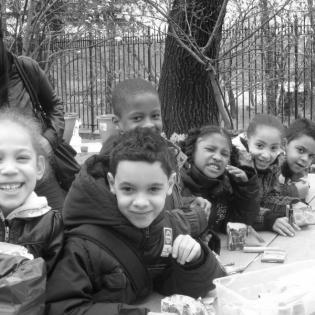Respect for Nature
Young people get outside and play in nature and recognize the beauty of diverse living things in their environment. Their service project is to take action to protect nature and share nature with someone else.
- observe diverse life in nature using all the senses.
- explore creative ways to get outside and enjoy nature in community with others.
- demonstrate stewardship for the environment.
- copies of handouts: Nature Scavenger Hunt and Interview an Older Friend about Outdoor Play
- cameras for student use (may be their phones)
Optional:
- a nearby area to observe nature
- blindfolds for each student (can be made out of cloth strips)
To build a love for nature and an understanding of stewardship, encourage young people to be playful and curious in nature. Give them lots of opportunity to get outside, investigate, talk about what they observe, dig in, feel protective, and run around.
- stewardship: (n) the careful and responsible management of something entrusted to one's care
- carbon footprint: the amount of carbon compounds emitted due to the consumption of fossil fuels by a particular person
- What did you observe with your senses? What looks different today than it did yesterday or last month (seasonal changes/human changes to environment)?
- What can we do to improve or take care of an outdoor space? Who else might enjoy that space?
- In what ways were you able to appreciate nature in this project? How did you help to show someone else the beauty in nature?
- How do you feel when you take care of nature? What are the benefits of being in nature?
Instructions
Anticipatory Set:
Share this quote and ask participants to explain what it means and why it might be important: "You should sit in nature for 20 minutes a day... unless you're busy, then you should sit in nature for an hour."
Walking Field Trip: Go for a walk and look for natural spaces. Use the attached scavenger hunt to guide learners on what to look for. Encourage young people to take photos of colors and textures in nature. Use as many senses as possible to enjoy the natural world. Participants write a sentence describing a way they used each sense. See the extension below for creating art out of the photos.
Ask, "Why is it important to get outside and not just stay indoors all the time?" Optional: they may conduct research on the benefits of being in nature.
- Makes you healthier
- Makes you happier
- Helps you sleep
- Taking care of nature keeps us alive because nature feeds us and helps us breathe.
Think, pair, share the meaning of "carbon footprint." After coming up with a definition, have them discuss with partners the impact on natural areas.
Think, pair, share the meaning of stewardship. Discuss the power they have over their own actions to stop wasting or polluting, and ways they can influence others to reduce the problem.
Have each individual or small group come up with one thing they can do to show responsibility for the environment. They write this on a sticky note and put on the board. Then as a group, start organizing the ideas/sticky notes in categories.
Project: Look at the sticky note ideas generated above, and plan one thing to do that involves interacting with nature with someone else. This may mean hiking in the woods, cleaning up a park with the neighborhood, designing a natural outdoor play space, playing group games, gardening with seniors, starting a recycle program, or learning to make or play old fashioned games and toys and teaching others how to play.
Think of things we can do that match our interests with building community in nature. This could be with older people, younger people, families, or other schools. Use social media to share your idea with others.
Make a plan and carry it out with the service-learning process. This video describes how to plan a project.
Extensions:
- Option One: Look at the photos taken during the walk and discuss the texture and color captured. Then have them choose one photo and use art materials to recreate a small part of the photo, focusing on the color, design, and texture. When the pictures are done, hang up the art and do a gallery walk past all the pictures, discussing what they see and what it makes them think and what it makes them feel. Art is more than elements of design; it communicates our feelings and attitudes about the subject. Discuss our feelings when we observe and interact with beautiful and diverse sounds, textures, colors in nature.
- Option Two: Nature has been our home and playground for a couple million years. We have been moving increasingly more indoors. Young people may interview someone from an earlier generation, like a parent, grandparent, or elderly friend. What changes have they seen? See Interview Questions handout below. The youth each write a brief description of an activity in nature practiced by their older friend, and share it with the class in a gallery walk the next day.
Writing prompt: "Write a paragraph telling what you will do to take care of and enjoy nature."
Philanthropy Framework
-
Strand PHIL.III Philanthropy and the Individual
-
Standard PI 01. Reasons for Individual Philanthropy
-
Benchmark MS.4 Identify and describe the actions of how citizens act for the common good.
-
Benchmark MS.5 Describe the responsibility students have to act in the civil society sector to improve the common good.
-
-
-
Strand PHIL.IV Volunteering and Service
-
Standard VS 01. Needs Assessment
-
Benchmark MS.1 Identify a need in the school, local community, state, nation, or world.
-
-
Standard VS 02. Service and Learning
-
Benchmark MS.1 Select a service project based on interests, abilities and research.
-
-
